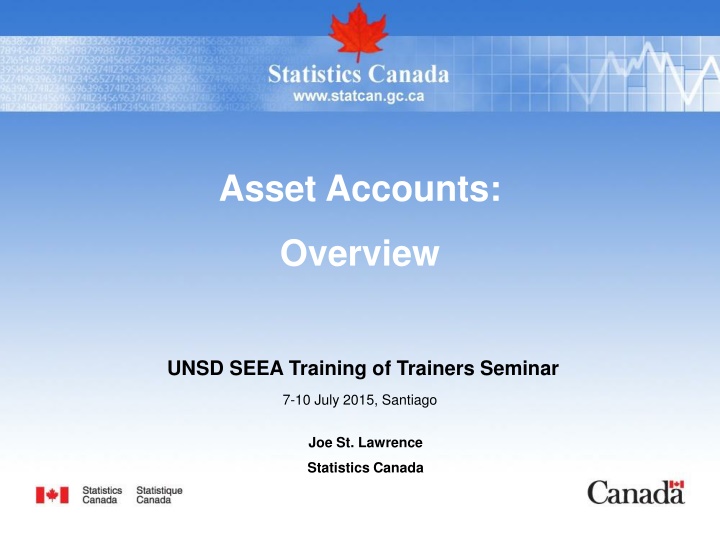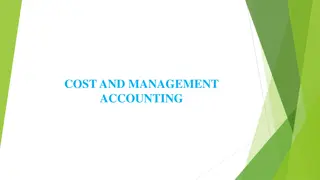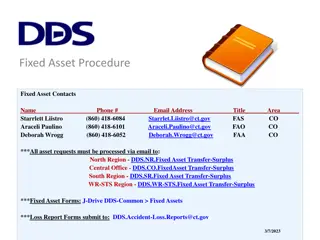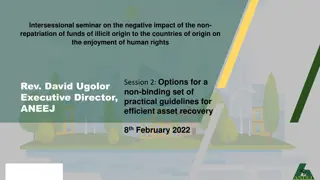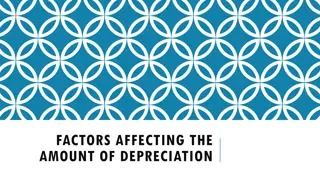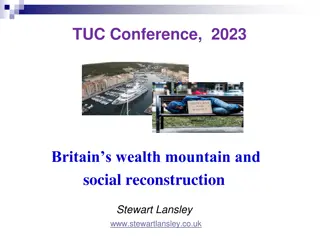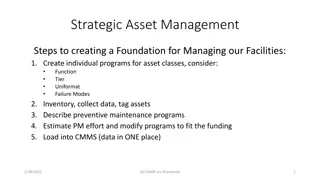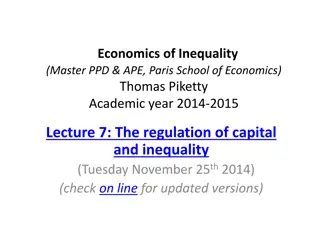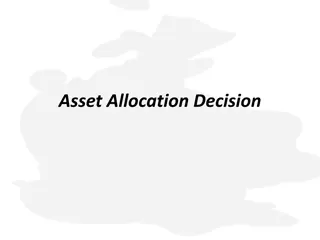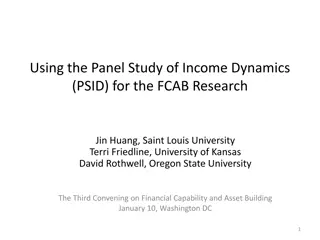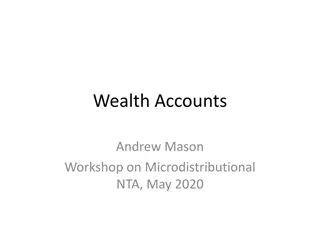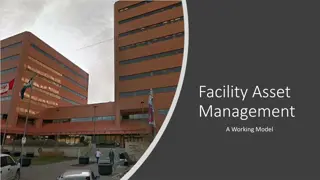Sustainable Asset Accounting and Natural Wealth Management Overview
This content delves into the importance of asset accounts in monitoring and managing natural wealth, highlighting the limitations of conventional economic indicators like GDP. It emphasizes the need to account for the use of environmental assets to ensure sustainable production and consumption practices for future ecosystem services. The material covers the structure of asset accounts, policy implications, and applications in evaluating the contribution of natural assets to national wealth and assessing resource substitution and rent recovery by governments.
Download Presentation

Please find below an Image/Link to download the presentation.
The content on the website is provided AS IS for your information and personal use only. It may not be sold, licensed, or shared on other websites without obtaining consent from the author.If you encounter any issues during the download, it is possible that the publisher has removed the file from their server.
You are allowed to download the files provided on this website for personal or commercial use, subject to the condition that they are used lawfully. All files are the property of their respective owners.
The content on the website is provided AS IS for your information and personal use only. It may not be sold, licensed, or shared on other websites without obtaining consent from the author.
E N D
Presentation Transcript
Asset Accounts: Overview UNSD SEEA Training of Trainers Seminar 7-10 July 2015, Santiago Joe St. Lawrence Statistics Canada
Outline Background The accounting structure Physical accounts Valuation Data sources Land, water, and ecosystem assets 2024-09-12 Statistics Canada Statistique Canada 2
Policy relevance Conventional economic aggregates generated through national accounting, such as GDP, do not reflect the extent to which production and consumption activities may be using up environmental assets and limiting the capacity for these assets to generate ecosystem services in the future. -TEEB Guidance Manual for Countries (2013) OECD: indicators and reports: Green Growth and Material Flows and Resource Productivity World Bank: Wealth Accounting and the Valuation of Ecosystem Services (WAVES) 2024-09-12 Statistics Canada Statistique Canada 3
Asset Accounts: Applications Monitoring and management of natural wealth What is the contribution of natural assets to national wealth? Are we maintaining total wealth (produced and natural) over time, both in total and per capita? To what extent are we substituting produced assets for natural assets? Is resource rent recovered successfully by governments? 2024-09-12 Statistics Canada Statistique Canada 4
2024-09-12 5 Statistics Canada Statistique Canada 5
SNA framework SNA framework Industries Final demand Assets Sectors Financial and produced assets, opening balance Industrial output of goods and services Industrial intermediate demand Gross fixed capital formation Final demand Commodities Wastes Other changes in volume & holding gains/losses on financial & produced assets Sectors Financial and produced assets, closing balance 2024-09-12 Statistics Canada Statistique Canada 6
SEEA framework SEEA framework Industries Final demand Assets Sectors Financial and produced assets, opening balance Natural resource assets, opening balance Natural resource assets, opening balance Industrial output of goods and services Industrial intermediate demand Gross fixed capital formation Final demand Commodities Environmental protection expenditures Environmental protection expenditures Capital expenditures for environmental protection Resource production by industries Resource production by households/gov t Resource use by industries Resource use by households/gov t Waste consumption by industries Waste consumption by households/gov t Wastes Waste output by industries Waste output by households/gov t Other changes in volume & holding gains/losses on financial & produced assets Changes in and holding gains/losses on natural resource assets Changes in natural resource assets Sectors Financial and produced assets, closing balance Natural resource assets, closing balance Natural resource assets, closing balance 2024-09-12 Statistics Canada Statistique Canada 7
Asset Accounting Asset Accounting Industries Final demand Assets Sectors Financial and produced assets, opening balance Natural resource assets, opening balance Natural resource assets, opening balance Industrial output of goods and services Industrial intermediate demand Gross fixed capital formation Final demand Commodities Environmental protection expenditures Environmental protection expenditures Capital expenditures for environmental protection Resource production by industries Resource production by households/gov t Resource use by industries Resource use by households/gov t Waste consumption by industries Waste consumption by households/gov t Wastes Waste output by industries Waste output by households/gov t Other changes in volume & holding gains/losses on financial & produced assets Changes in and holding gains/losses on natural resource assets Changes in natural resource assets Sectors Financial and produced assets, closing balance Natural resource assets, closing balance Natural resource assets, closing balance 2024-09-12 Statistics Canada Statistique Canada 8
Accounting structure conforms with a balance sheet structure - opening stocks, closing stocks and annual variations United Nations, 2012, System of Environmental-Economic Accounting: Central Framework (white cover draft), New York. http://unstats.un.org/unsd/envaccounting/White_cover.pdf Statistics Canada Statistique Canada 9 2024-09-12
Physical stock accounts: an example for crude bitumen 2024-09-12 Statistics Canada Statistique Canada 10
Accounting structure Question: what factors could lead to the large jump in stocks in 2006? 2024-09-12 Statistics Canada Statistique Canada 11
Accounting structure Question: what factors could lead to the large jump in stocks in 2006? Prices increase making existing deposits profitable to extract. New technology making extraction more profitable or opening formerly unrecoverable stocks to exploitation. 2024-09-12 Statistics Canada Statistique Canada 12
Monetary Monetary stock accounts: an example for crude bitumen 2024-09-12 Statistics Canada Statistique Canada 13
Accounting structure Question: what factors could lead to the large revaluation in 2009? 2024-09-12 Statistics Canada Statistique Canada 14
Accounting structure Question: what factors could lead to the large revaluation in 2009? The economic crisis leading to a drop in prices. 2024-09-12 Statistics Canada Statistique Canada 15
Links to the SNA The monetary accounts are integrated with the National Wealth Account of the CSNA The addition of the monetary values of key natural resource assets (energy, minerals, timber and land) recognizes that these resources, although provided by nature, contribute significantly to Canada s national wealth 2024-09-12 Statistics Canada Statistique Canada 16
Natural resource assets in context Natural resource assets in context Non-financial assets 9,000,000 8,000,000 7,000,000 6,000,000 million dollars 5,000,000 Non-produced non-financial assets 4,000,000 Produced non-financial assets 3,000,000 2,000,000 1,000,000 0 2009 2010 2011 2012 2013 2024-09-12 Statistics Canada Statistique Canada 17
Natural resource assets in context Natural resource assets in context Non-produced non-financial assets 4,000,000 3,500,000 3,000,000 2,500,000 million dollars Selected mineral resources2 Selected energy resources1 2,000,000 Timber 1,500,000 Land 1,000,000 500,000 0 2009 2010 2011 2012 2013 2024-09-12 Statistics Canada Statistique Canada 18
Accounting structure Is wealth really going up like this all the time? 2024-09-12 Statistics Canada Statistique Canada 19
Accounting structure Is wealth really going up like this all the time? Not really, since the stock is valued in current prices and includes inflation. 2024-09-12 Statistics Canada Statistique Canada 20
Accounting structure Why value assets in current prices? 2024-09-12 Statistics Canada Statistique Canada 21
Accounting structure Why value assets in current prices? The assumptions on resource rent, stocks, extraction, etc. are all based on current prices. 2024-09-12 Statistics Canada Statistique Canada 22
Natural Resource Stock Accounts: Applications Physical indicators that relate to the management of natural resource stocks and their use in the economy Are resource stocks growing / declining over time? Stocks of mineral and energy assets Remaining reserve life of energy and mineral assets Annual depletion of mineral and energy reserves Total natural resource base Monetary indicators that tell us if our resource base (natural wealth) is being maintained or at least replaced by adequate produced capital. 2024-09-12 Statistics Canada Statistique Canada 23
Physical stocks of selected assets 2024-09-12 Statistics Canada Statistique Canada 24
Reserve life for selected resources, 1990 to 2012 (Closing stock)/(extraction) 2024-09-12 Statistics Canada Statistique Canada 25
Physical stocks of selected minerals How can we have 10 years of crude oil for the last 17 years? 2024-09-12 Statistics Canada Statistique Canada 26
Physical stocks of selected minerals How can we have 10 years of crude oil for the last 17 years? Extraction is balanced by discoveries and other additions to stock. 2024-09-12 Statistics Canada Statistique Canada 27
How are natural resources valued? In order to be included within the balance sheet accounts, natural resource assets must fit into the asset boundary of the SNA i.e. they must be economic assets Economic assets are entities over which ownership rights are enforced by institutional units, individually or collectively, and from which economic benefits may be derived by their owners by holding them, or using them, over a period of time They also must be recoverable under current technological and economic conditions E.g., for oil sands (crude bitumen) we only value known deposits under active development Statistics Canada Statistique Canada 2024-09-12 28
Valuation of energy and mineral stocks Valuation: indirect estimation of market values of natural assets Valuation of natural resource asset stocks would ideally be based on observed market value for transactions in these assets Such values are not available for most resource assets however, since there are few transactions in resource assets in their natural state Estimates of market value must be derived indirectly (economic or resource rent) The total value, or wealth, associated with the stock is calculated as the present value of all future annual rent that the stock is expected to yield 2024-09-12 Statistics Canada Statistique Canada 29
The concept of resource rent Resource rent is the part of the revenue from the sale of the resource which remains after having deducted all costs associated with extraction including fuel, labour and capital costs. 2024-09-12 Statistics Canada Statistique Canada 30
Calculation of resource rent RRI = TR - C - (rcK + ) where: RR = resource rent (annual) TR = total annual revenue C = annual non-capital extraction cost (excluding taxes) = annual depreciation rcK = return to produced capital 2024-09-12 Statistics Canada Statistique Canada 31
Valuation Net present value Net present value (NPV) is the discounted value of future economic benefits from a given asset Follows conventions adopted in the System of National Accounts to value capital assets = + t 1 1 T RR = 1 NPV ( ) t ir where: RR=resource rent T= reserve life, i.e. Closing stock extraction ri= discount rate 2024-09-12 Statistics Canada Statistique Canada 32
Valuation Estimate the stock A B C D E F G H I J K L M N O P Crude Bitumen - 211114 Reserves under active development 4.00% = Discount rate Physical accounts GEOMETRIC Total production costs Return to capitalTotal extraction Additions / Revisions Depletion / Quantity of production Total revenues Depreciation Net capital stock Rate of return Resource rent Opening Stock Closing Stock Reserve life Discount factor Net Present Value costs Year '000 m '000 m '000 m '000 m years % $'000 000 $ '000 $ '000 $ '000 $ '000 $ '000 $ '000 $ '000 Rate of return folder CAPP1 CAPP2 CANSIM 031-00023 AER ST984 AER ST984 (E*F) (C+D+G) (B-H) (Mt-1) (M-J+L) (M/L) (PV(N$2,N##,-1/N##)) (I*N*O)/1000 1 10,000.00 4,000.00 100.00 10,000.00 0.02 200.00 4,300.00 5,700.00 .. 100,000 1,000 99,900 99.90 0.25 139.67 2024-09-12 Statistics Canada Statistique Canada 33
Valuation Estimate the rent A B C D E F G H I J K L M N O P Crude Bitumen - 211114 Reserves under active development 4.00% = Discount rate Physical accounts GEOMETRIC Total production costs Return to capitalTotal extraction Additions / Revisions Depletion / Quantity of production Total revenues Depreciation Net capital stock Rate of return Resource rent Opening Stock Closing Stock Reserve life Discount factor Net Present Value costs Year '000 m '000 m '000 m '000 m years % $'000 000 $ '000 $ '000 $ '000 $ '000 $ '000 $ '000 $ '000 Rate of return folder CAPP1 CAPP2 CANSIM 031-00023 AER ST984 AER ST984 (E*F) (C+D+G) (B-H) (Mt-1) (M-J+L) (M/L) (PV(N$2,N##,-1/N##)) (I*N*O)/1000 1 10,000.00 4,000.00 100.00 10,000.00 0.02 200.00 4,300.00 5,700.00 .. 100,000 1,000 99,900 99.90 0.25 139.67 RRI = TR - C - (rcK + ) where: RR = resource rent (annual) TR = total annual revenue C = annual non-capital extraction cost (excluding taxes) = annual depreciation rcK = return to produced capital 2024-09-12 Statistics Canada Statistique Canada 34
Valuation Net Present Value A B C D E F G H I J K L M N O P Crude Bitumen - 211114 Reserves under active development 4.00% = Discount rate Physical accounts GEOMETRIC Total production costs Return to capitalTotal extraction Additions / Revisions Depletion / Quantity of production Total revenues Depreciation Net capital stock Rate of return Resource rent Opening Stock Closing Stock Reserve life Discount factor Net Present Value costs Year '000 m '000 m '000 m '000 m years % $'000 000 $ '000 $ '000 $ '000 $ '000 $ '000 $ '000 $ '000 Rate of return folder CAPP1 CAPP2 CANSIM 031-00023 AER ST984 AER ST984 (E*F) (C+D+G) (B-H) (Mt-1) (M-J+L) (M/L) (PV(N$2,N##,-1/N##)) (I*N*O)/1000 1 10,000.00 4,000.00 100.00 10,000.00 0.02 200.00 4,300.00 5,700.00 .. 100,000 1,000 99,900 99.90 0.25 139.67 T RR 1 = t = 1 NPV ( ) t + ir 1 2024-09-12 Statistics Canada Statistique Canada 35
Data sources: Monetary data Generally, the data in monetary terms come from Statistics Canada. Those data include (but not exclusively): Value and quantity of production Capital expenditures Operating costs (materials and supplies, fuel and electricity, and wages and salaries) Value of the produced capital stock and the value of the annual depreciation of that stock 2024-09-12 Statistics Canada Statistique Canada 36
Data sources: Physical data Generally, the data in physical terms (mainly reserve estimates) come from Federal and Provincial natural resource departments. Data suppliers include: Natural Resources Canada Canadian Association of Petroleum Producers Alberta Energy Regulator British Columbia Ministry of Energy, Mines and Petroleum Resources Manitoba Energy and Mines, Petroleum and Energy Branch Saskatchewan Department of Energy and Mines 2024-09-12 Statistics Canada Statistique Canada 37
Land Assets The Land Accounts provide information on the cover and the use of Canada s land Respond to questions like: What is the distribution and quality of the land? How is land used and what are the trends in this use? How quickly is rural land being converted to urban land? What share of urban land is occupying prime agricultural land? At the moment, only agricultural and built-up land are valued and included in the country s National Wealth Account In future we hope to develop methods and estimates for other land types, such as parkland and recreational land 2024-09-12 Statistics Canada Statistique Canada 38
Land use change 2024-09-12 Statistics Canada Statistique Canada 39
Land characteristics 2024-09-12 Statistics Canada Statistique Canada 40
Water stocks 2024-09-12 Statistics Canada Statistique Canada 41
Questions? Questions? Joe St. Lawrence Joe St. Lawrence Statistics Canada | 170 Tunney's Pasture Driveway, Ottawa ON K1A 0T6 Statistics Canada | 170 Tunney's Pasture Driveway, Ottawa ON K1A 0T6 Statistique Statistique Canada | 170, promenade Tunney's Pasture, Ottawa ON K1A 0T6 Canada | 170, promenade Tunney's Pasture, Ottawa ON K1A 0T6 Joe.St.Lawrence@statcan.gc.ca Joe.St.Lawrence@statcan.gc.ca Telephone | Telephone | T l phone T l phone 613 613- -882 882- -8598 8598 Facsimile | Facsimile | T l copieur T l copieur 613 613- -951 951- -0634 0634 Government of Canada | Government of Canada | Gouvernement Gouvernement du Canada du Canada 2024-09-12 Statistics Canada Statistique Canada 42
